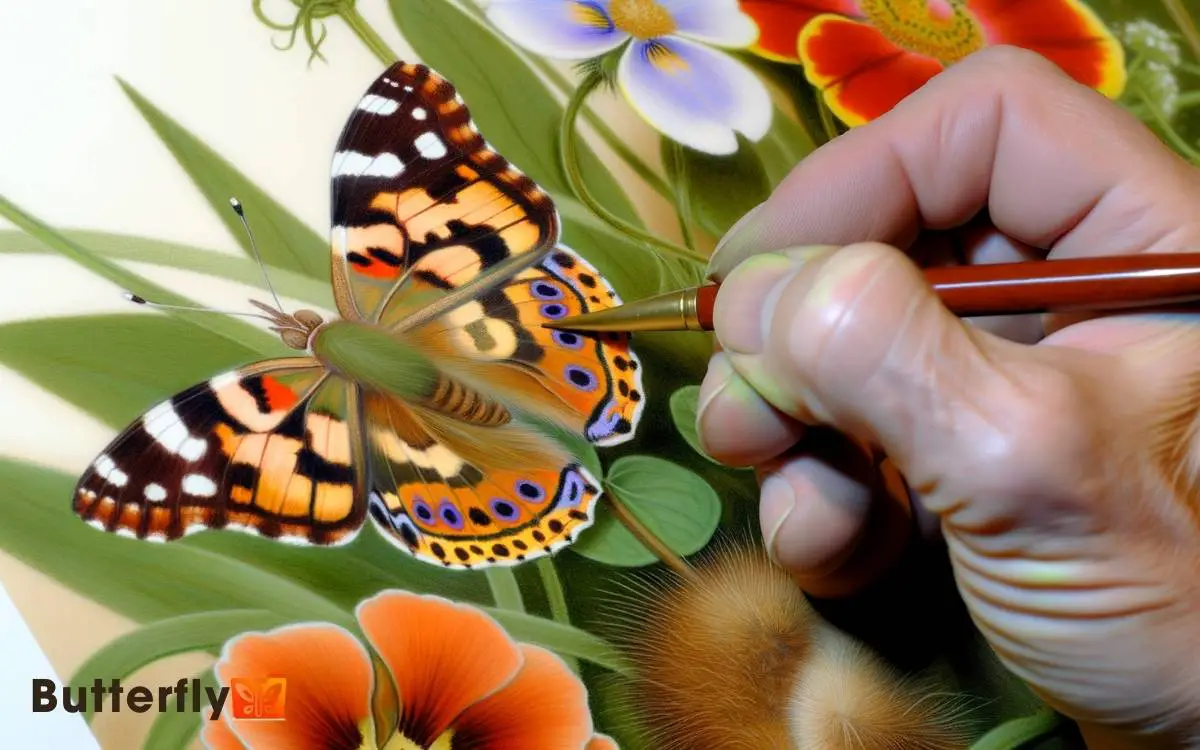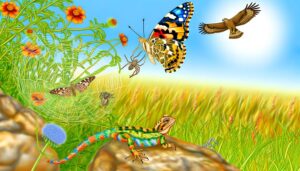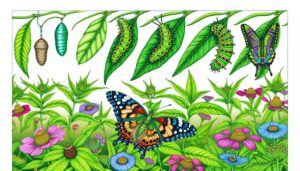How to Draw a Painted Lady Butterfly? Step-by-Step Guide!
To draw a Painted Lady butterfly, start with high-quality pencils, a suitable paper, precision erasers, and a sharpener.
Begin by sketching a central axis for symmetry, and outline the thorax, abdomen, head, and antennae. Indicate wing placement with accurate angles.
Replicate the wing’s intricate patterns, focusing on symmetry with fine-tipped pencils. Use colored pencils or watercolors to apply an orange base, adding depth with darker shades.
Highlight spots with white or yellow strokes. Finish by refining wing edges and adding details like black spots and thin antennas. Master these steps to achieve a lifelike representation.

Key Takeaways
Gathering Your Materials
To begin drawing a Painted Lady butterfly, one needs to gather essential materials including high-quality pencils, erasers, and suitable paper. High-quality pencils, ranging from 2H to 6B, are essential for achieving varying degrees of shading and detail.
Precision erasers, such as kneaded or vinyl types, allow for meticulous corrections without damaging the paper. Suitable paper should have a smooth texture to enable fine details while being thick enough to withstand multiple erasures.
Additionally, a sharpener and a ruler are recommended for maintaining pencil sharpness and ensuring accurate proportions, respectively.
Each of these materials contributes significantly to capturing the intricate patterns and vibrant colors of the Painted Lady butterfly, ultimately resulting in a scientifically accurate and aesthetically pleasing drawing.
Sketching the Basic Outline
Begin by lightly drawing the central axis of the Painted Lady butterfly’s body to guarantee symmetry. This axis will serve as a reference point for both the thorax and abdomen.
Next, outline the oval shape of the thorax and the elongated, slightly curved abdomen.
Follow these steps for accurate proportions:
- Thorax and Abdomen: Sketch an oval for the thorax and a tapered shape for the abdomen, ensuring they align with the central axis.
- Head: Draw a small circle at the top of the thorax for the head.
- Antennae: Add two thin, curved lines extending from the head.
- Wing Placement: Indicate the primary angles where the wings will attach to the thorax.
These steps form the essential skeletal structure of the butterfly.
Drawing the Wing Patterns
With the basic outline in place, the artist can now focus on accurately replicating the intricate patterns on the Painted Lady butterfly’s wings. Each wing boasts a series of distinct markings, including white spots, black lines, and orange patches.
The forewings display a significant black apex with white dots, while the hindwings feature rows of smaller eyespots near the edges. To capture these details, the artist should use a fine-tipped pencil to outline each pattern element precisely.
Paying close attention to symmetry is essential, as the butterfly’s wings are mirror images. By meticulously following these steps, the artist makes sure that the wing patterns are both accurate and detailed, laying a strong foundation for the next phase in the drawing process.
Adding Color and Texture
Incorporating vibrant hues and delicate textures, the artist meticulously applies colored pencils or watercolors to bring the Painted Lady butterfly to life. The process requires a nuanced understanding of the butterfly’s natural pigmentation and wing patterns. Each stroke captures the intricate details of its wings, from the bold black markings to the subtle orange gradients. To ensure accuracy, the artist studies reference images and even observes live specimens fluttering near flower gardens. Observing their behavior, such as feeding habits, might also involve learning how to make sugar water to attract these butterflies for closer examination.
- Base Layer: The artist begins with a light base layer of orange to fill the primary wing areas.
- Shading: They add depth using darker shades of brown and black, especially near the edges and vein lines.
- Highlights: White or light yellow pencils highlight the intricate spots and markings.
- Texture: To simulate the delicate scales, the artist uses fine, short strokes, enhancing the realistic texture.
Through these steps, the artwork captures the intricate beauty and complexity of the Painted Lady butterfly.
Final Touches and Details
As the artist approaches the final touches, they meticulously refine the wing edges and add the smallest details, ensuring every spot and line mirrors the Painted Lady butterfly’s natural elegance.
Each element is carefully considered to reflect the butterfly’s intricate patterns and vibrant coloration.
To enhance understanding, here’s a breakdown of key details:
| Detail | Description |
|---|---|
| Wing Edges | Smooth, slightly scalloped |
| Black Spots | Uniform, precisely placed |
| Orange Patterns | Vivid, symmetrical, and gradient-filled |
| Antennae | Thin with distinct clubs at ends |
Conclusion
To sum up, drawing a painted lady butterfly is a delicate dance of precision and creativity. With materials gathered, the basic outline sketched, wing patterns meticulously drawn, and vibrant colors added, the butterfly comes to life on the canvas.
Attention to detail in the final touches guarantees an accurate, lifelike representation. This artistic journey, grounded in scientific observation, transforms a blank page into a fluttering masterpiece, echoing nature’s intricate beauty in every stroke.






